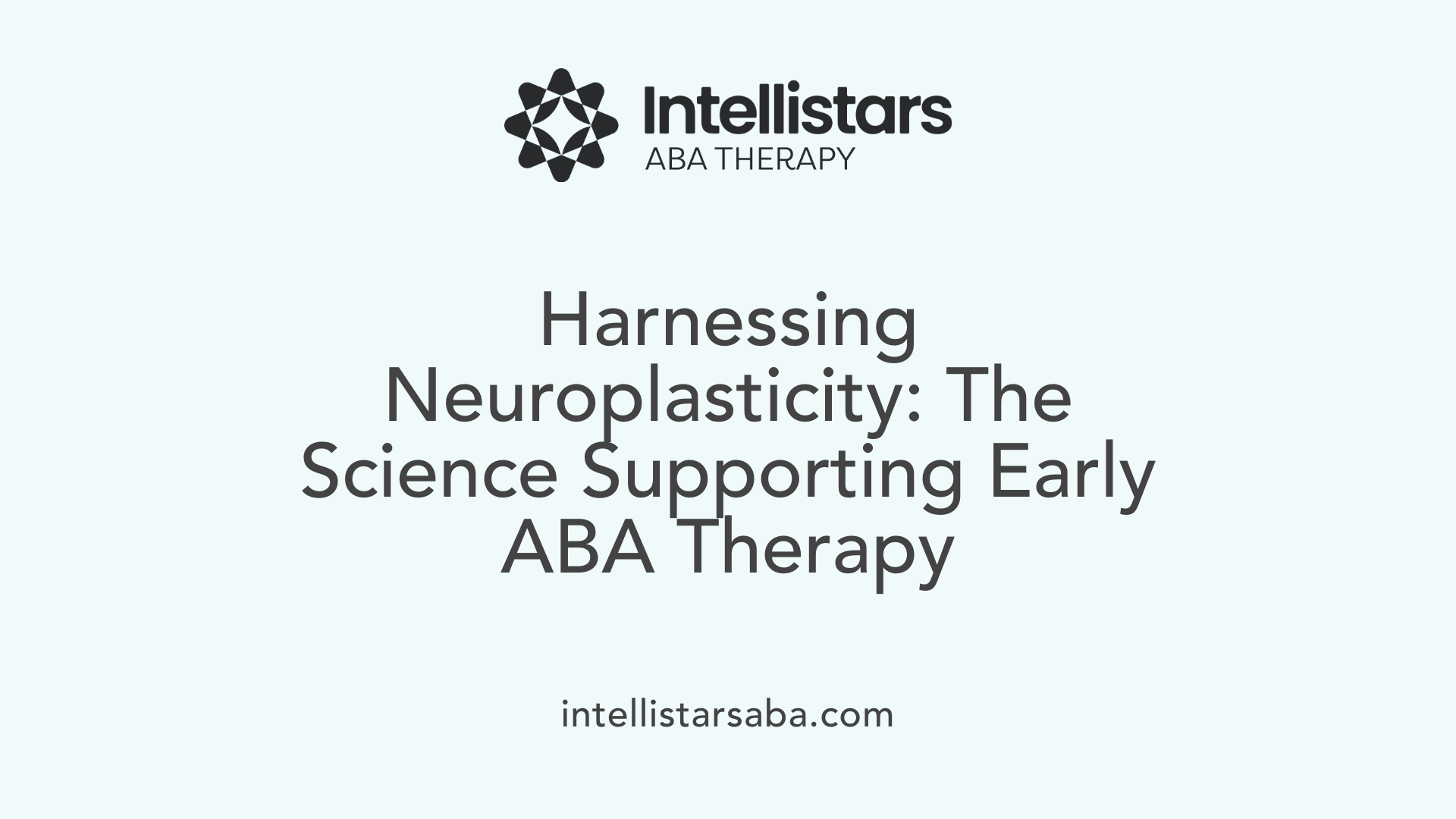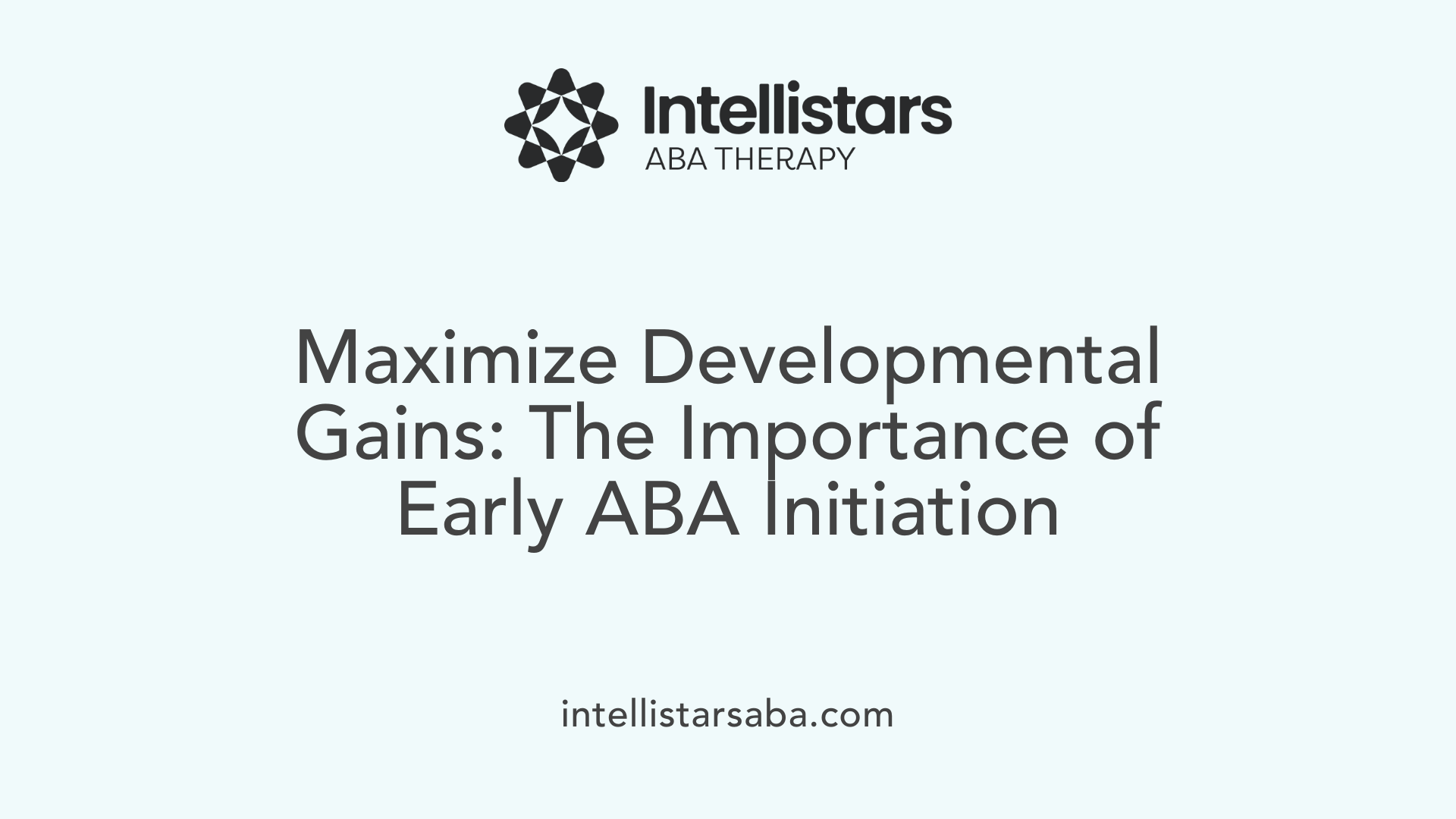Understanding the Optimal Timing for ABA Therapy
Applied Behavior Analysis (ABA) is a science-backed approach essential for supporting children with autism. The timing of its initiation greatly influences therapeutic success, developmental progress, and long-term quality of life. While the ideal age for starting ABA therapy is generally between 2 and 6 years, understanding the nuances of early intervention and the factors influencing age appropriateness can help caregivers and professionals make informed decisions.
The Science Behind Early Intervention and Brain Plasticity

Why is early intervention with ABA therapy important for children with autism?
Early intervention with Applied Behavior Analysis (ABA) therapy is vital because of the brain's extraordinary ability to adapt and change during early childhood—a concept known as neuroplasticity. During the first few years of life, the brain is highly receptive to learning, making this window ideal for implementing therapeutic strategies.
Research shows that starting ABA therapy as early as 18 months can significantly improve key developmental areas such as language, social interaction, and behavioral regulation. When therapy begins during this critical period, it encourages the formation of new neural pathways, helping children develop skills more naturally and efficiently.
The benefits of early ABA intervention extend beyond immediate skill acquisition. Longitudinal studies suggest that children who receive early intervention maintain their progress into adolescence and even adulthood. These children often display higher IQ scores, better communication abilities, and reduced severity of autism symptoms over time.
Family involvement and tailored strategies are integral parts of early ABA therapy. They help optimize each child's unique developmental potential, addressing specific needs and reinforcing skills in daily life. Overall, initiating ABA therapy early optimizes brain development, increasing the likelihood of greater independence and a higher quality of life in the long run.
Age Range and Developmental Stages for Initiating ABA Treatment
Typical age ranges for therapy initiation
Applied Behavior Analysis (ABA) therapy is most effective when started during early childhood, ideally before age four. The optimal window for beginning intervention is generally between ages 2 and 6, capturing a period when the brain is especially receptive to learning due to enhanced plasticity. Early intervention, particularly around ages 0 to 2, can significantly impact long-term outcomes, improving communication skills, social interaction, and adaptive behaviors.
Children are often diagnosed with autism by age 3, and this is when many begin ABA therapy. However, some children are diagnosed later, even into adolescence or adulthood. Despite this, ABA principles can be tailored to any age, making it a versatile approach to support behavioral improvements across the lifespan.
Developmental milestones and ABA
Starting ABA during critical developmental periods allows children to acquire essential social and communication skills, such as eye contact, vocalizations, and imitation. When intervention occurs early, it leverages the brain’s high adaptability, facilitating progress in language development, play skills, and social interactions.
For infants as young as 6 months, ABA-based models like the Early Start Denver Model (ESDM) are used to focus on foundational social communication skills. ESDM emphasizes engaging infants in eye contact, joint attention, and social engagement, promoting early developmental milestones.
Use of models like ESDM for infants
The Early Start Denver Model (ESDM), rooted in ABA, is suitable for children from as young as 6 months. It incorporates play-based and naturalistic teaching strategies to enhance social communication and emotional connection. ESDM aims to support infants in achieving key milestones such as responding to their name, making eye contact, and participating in joint attention activities.
While traditional ABA therapy is common for preschool-aged children and older, ESDM provides a proactive approach for very young children, emphasizing early developmental support. Initiating intervention early, using tailored models like ESDM, maximizes the benefits of therapy and can positively influence long-term developmental trajectories.
The Recommended Age to Commence ABA for Children with Autism
What is the recommended age to start ABA therapy for children with autism?
The best time to begin ABA therapy is as early as possible, ideally between 1 and 3 years old. Early intervention is crucial because it leverages the brain's plasticity during the first few years of life, making it easier to teach essential skills.
Children with autism are often diagnosed by age 3, but sometimes diagnoses are delayed until adolescence or adulthood. Starting therapy early, even around 6 months old with models like the Early Start Denver Model (ESDM), can significantly improve language, social, and behavioral skills.
Most children typically begin ABA between ages 2 and 6, which is considered an optimal period for intervention. Initiating treatment during this window helps to mitigate developmental delays and prevents challenging behaviors from becoming deeply ingrained.
While earlier therapy tends to produce better outcomes, ABA is effective for individuals of all ages. No matter the age, starting at any point can help develop communication, social interaction, and self-care skills, ultimately enhancing quality of life. The flexibility of ABA allows it to be adapted to meet the needs of children, adolescents, and adults alike.
Why is early intervention so beneficial?
Beginning ABA during early childhood helps address critical developmental stages, supporting foundational skills like eye contact, vocalization, and imitation. Early therapy can also prevent more complex challenges later and promotes independence. As a science-based approach, ABA uses positive reinforcement and data-driven strategies, making it a versatile and effective tool for improving life outcomes for individuals with autism.
Efficacy of ABA Beginning at Different Ages

How effective is ABA therapy when started at different ages?
Research consistently shows that ABA (Applied Behavior Analysis) therapy yields the best results when introduced early in a child's developmental period. Most notably, initiating therapy between the ages of 2 and 6, with the ideal window being before age four, allows clinicians to leverage the brain’s heightened plasticity during these formative years.
Starting ABA early can significantly enhance language development, social skills, and daily living abilities. These improvements are often sustained over time, with longitudinal studies indicating continued benefits up to 18 years later. The earlier the intervention, the more effective it is in teaching fundamental skills like eye contact, vocalization, and imitation, which serve as building blocks for further learning.
While early intervention, especially between birth and age two, can profoundly impact long-term outcomes, ABA remains effective at any age. For older children, teens, and even adults, ABA can be tailored to specific behavioral challenges and skill development goals. Although the intensity of intervention may vary—frequently involving fewer hours and a less structured approach—the core principles still facilitate meaningful improvements.
Age interacts with factors like treatment duration and intensity. Generally, more frequent sessions and early start times are associated with more substantial progress. Personalization of ABA plans by qualified professionals ensures that therapy adapts to each individual’s developmental stage and needs.
In summary, while starting ABA as early as possible offers the highest potential for developmental gains, it is never too late to benefit from this science-based approach. Whether begun in infancy or adulthood, ABA remains a valuable tool in promoting positive behaviors, skill acquisition, and enhanced quality of life.
Lifespan Adaptability of ABA Interventions

Can ABA therapy be adapted for individuals across different ages and throughout their lifespan?
Absolutely. ABA (Applied Behavior Analysis) is a flexible and scientific approach that can be tailored to individuals of any age. Although it is most effective when started early in childhood—particularly between 2 and 6 years old, utilizing brain plasticity to foster critical developmental skills—its principles are applicable throughout life.
For infants and toddlers, ABA techniques focus on building foundational skills such as eye contact, vocalization, imitation, and basic social interactions. Programs like the Early Start Denver Model (ESDM) are designed specifically for children as young as 6 months, emphasizing social communication from a very early age.
As children grow, ABA can be adapted to address increasingly complex skills, including language development, social interaction, and play. For school-aged children, ABA still plays a vital role in improving communication and behavioral skills, helping them participate actively in educational settings.
The flexibility of ABA extends beyond childhood. For adolescents, therapy can target specific issues like social skills, emotional regulation, or independence in daily tasks. It is also widely used in adult populations to promote workplace skills, community integration, and self-care.
Older adults, particularly those with autism, intellectual disabilities, or medical conditions, also benefit from ABA strategies designed to support independence, safety, and quality of life. Therapy sessions might focus on living skills, safety behaviors, or adaptation to health changes.
In all cases, professionals including Board Certified Behavior Analysts (BCBAs) personalize goals, methodologies, and tools to suit the individual’s age, needs, and environment. Family involvement and community support further enhance the effectiveness of ABA interventions throughout a person’s life.
Therefore, there is no age cutoff for ABA. Its principles are adaptable and continually evolving to help individuals live more independent, fulfilling lives at any stage.
The Critical Role of Individualized Assessment and Planning

What factors should be considered when choosing the appropriate age to start ABA treatment?
Selecting the right age to begin ABA therapy involves several important considerations. Typically, the most advantageous period is during early childhood, particularly between 12 months and 6 years old. This is because the brain exhibits high plasticity during these years, making it an optimal window for developing vital skills such as communication and social interaction.
However, the child's developmental level, symptom severity, and specific behavioral challenges play significant roles in the timing of intervention. For example, some children may need earlier intervention to address critical developmental delays, while others might benefit from starting at a slightly later stage due to their unique needs.
Family circumstances, including available support systems and resources, also influence the decision. Early intervention not only enhances the chances of improving social and language skills but also helps in preventing the escalation of challenging behaviors.
While initiating ABA therapy early tends to yield the best outcomes, it is never too late to start. For older children and even adults, ABA principles can be adapted to focus on developing independence, communication, and community participation.
Ultimately, the decision on when to begin should be individualized. An evaluation conducted by a qualified BCBA ensures that treatment is tailored to the child's specific developmental status and needs, leading to the most effective outcomes.
Goals and Techniques in ABA Therapy
What are the main goals of ABA therapy?
Applied Behavior Analysis (ABA) therapy is designed to support individuals with autism and other developmental disorders by helping them acquire essential skills and reduce problematic behaviors. The primary objectives include improving communication, social interaction, self-care abilities, play skills, and motor functions. Each plan is tailored to the individual's unique needs, ensuring personalized progress.
ABA emphasizes positive reinforcement—rewarding desirable behaviors to encourage their recurrence—while systematically collecting data to monitor progress. Adjusting goals based on ongoing assessments allows therapy to remain effective and responsive.
What methods are used in ABA for different ages?
ABA employs a variety of instructional techniques suited to different developmental stages. For very young children, especially infants and toddlers, methods like Early Intensive Behavioral Intervention (EIBI) and the Early Start Denver Model (ESDM) are common. These approaches focus on early social communication, imitation, and play development.
For school-aged children and older individuals, techniques like Pivotal Response Treatment (PRT), Natural Environment Teaching (NET), and JASPER (Joint Attention, Symbolic Play, Engagement, and Regulation) are used. These methods promote learning in natural settings and foster skills that are directly applicable to daily life.
Implementation of these methods involves engaging activities and positive reinforcement to motivate skill acquisition while avoiding negative approaches.
How is punishment avoided, and what strategies are emphasized?
A core principle of ABA is avoiding punishment-based discipline. Instead, the focus is on positive reinforcement, encouraging good behaviors through rewards such as praise, tokens, or preferred activities. This approach fosters motivation and a positive learning environment.
ABA also involves carefully understanding triggers for challenging behaviors. By teaching safer and more functional responses, therapists help individuals communicate their needs effectively, reducing safety risks.
Incorporating parents and caregivers into therapy sessions ensures consistency across settings, which enhances learning and generalization of skills.
| Aspect | Description | Additional Details |
|---|---|---|
| Main Goals | Develop communication, social, self-care, play, and motor skills | Personalized plans, positive reinforcement, data-driven adjustments |
| Techniques | EIBI, ESDM, PRT, NET, JASPER | Suitable for different ages and developmental stages |
| Punishment Avoidance | Focus on reinforcement over punishment | Safety and communication are prioritized |
By integrating these strategies, ABA creates a supportive environment that promotes meaningful growth across a lifespan.
Implementation and Role of Families and Caregivers

How is ABA therapy typically implemented, and what role do families play?
ABA therapy starts with a comprehensive evaluation conducted by a qualified Board Certified Behavior Analyst (BCBA). Based on this assessment, personalized goals and intervention plans are created to meet each individual’s unique needs.
The therapy can be delivered in various settings. For infants and toddlers, in-home environments are commonly used, allowing therapists to work within familiar surroundings and involve parents actively. For children aged 4 and above, center-based programs are more typical, offering structured environments designed to promote skill development in a social context.
Family involvement is a cornerstone of successful ABA treatment. Caregivers are trained by professionals to incorporate therapy techniques into daily routines. This practice helps reinforce learning and accelerates progress across different settings.
Natural Environment Teaching (NET) emphasizes learning in everyday situations such as play, meal times, or outings. This approach makes learned skills more functional and easier for children to generalize across places and people.
Parents and family members play a vital role by supporting consistent application of strategies, practicing new skills at home, and advocating for their child's needs. Their active participation not only boosts the effectiveness of therapy but also enhances the child’s confidence and independence.
Ultimately, combining professional guidance with family engagement creates a supportive, real-world context for meaningful skill acquisition and behavior change, fostering long-term developmental growth.
Understanding the Scope and Limitations of ABA Therapy
How effective is ABA therapy when started at different ages?
Research shows that ABA (Applied Behavior Analysis) therapy yields the best results when initiated during early childhood, especially between the ages of 2 and 6. Beginning ABA therapy before age four leverages brain plasticity, which facilitates more significant improvements in language development, social skills, and adaptive behaviors.
Studies indicate that children who start early tend to maintain their gains over time, with benefits persisting into adolescence and even adulthood. For example, a longitudinal study suggests that intermediate progress made during early intervention can be sustained long-term.
While starting age is a crucial factor, the therapy’s effectiveness also depends on the intensity and consistency of intervention. More sessions per week or longer daily sessions generally lead to better mastery of skills, particularly when started early. However, it’s important to note that ABA is adaptable.
For older children, teenagers, and adults, ABA can still be beneficial. Although the approach may shift toward less intensive and more individualized plans, it continues to address specific behavioral issues, communication challenges, and social skills—improving overall quality of life.
In summary, initiating ABA early maximizes developmental gains, but the therapy remains effective throughout life. Personalized programs that consider age, needs, and available resources ensure that individuals of all ages can benefit from ABA, reinforcing its role as a lifelong support tool.
Harnessing the Power of Early and Lifelong Intervention
While the ideal window for initiating ABA therapy is between 2 and 6 years, its principles and techniques are adaptable across the lifespan. Early intervention during critical developmental periods offers the greatest potential for maximizing a child's communication, social, and adaptive skills. However, ABA remains a versatile and effective approach for individuals of all ages, helping to address behavioral challenges, foster independence, and improve overall quality of life. Prompt diagnosis and timely implementation of tailored ABA programs are key. Embracing a lifelong perspective on ABA's application ensures continuous support and development for individuals with autism, ultimately enriching their capacity to participate fully in life.
References
- ABA Therapy Age Limits & Age Range Based on Evidence
- When to Start ABA Therapy
- Questions and answers about ABA
- When is the Best Age to Start ABA Therapy for Autism?
- ABA Therapy Age Limits & Age Range Based on Evidence
- Applied Behavior Analysis (ABA) for Children With Autism
- When to Start ABA Therapy
- Best Age to Start ABA Therapy for Children






